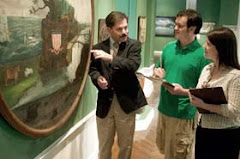A couple of weeks ago I was touring a group from the Historical Society of Early American Decoration through our collections storage and came across this painted box. It was tucked away on a lower shelf next to some clocks, but it looked interesting so I pulled it out and showed it to the group. You would have thought they had seen a rock star. All of a sudden, cameras came out of nowhere and the papparazzi began clicking away.
It is a terrific box, with a stylized landscape and architectural features ala Rufus Porter. Here's another detail:
That's quite a fanciful church steeple or tower! I didn't have any information about the box but one of the group members did. She is an expert of Rufus Porter and sent me this image of a similar box erroneously attributed to him and sold at Sothebys as part of the Thayer sale in 1987. Here it is:
This box descended in a Frederick County, Maryland, family but there is no evidence it originated there. It would be nice to find more examples and determine who this artist may have been. If you've seen anything similar, you know where to find me.






















